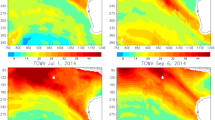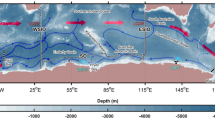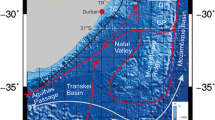Abstract
The spreading pathways of the Somali and Arabian coastal upwelled waters in the northern Indian Ocean are identified from an ocean re-analysis data set of a single year using numerical passive tracers in a transport model. The Somali and Arabian coastal upwelled waters are found to have entirely different spreading pathways in the northern Indian ocean. The former circulates anticyclonically, is mixed vertically, and is advected to the eastern Indian Ocean along the north equatorial region; while the later intrudes into the northern Arabian Sea, circulates anticyclonically and is advected to the south in the central Arabian Sea and then to the eastern Indian Ocean. The seasonal surface mixing by strong monsoon winds and sheared currents due to dominant eddies of the Somali region are found responsible for mixing 25% of Somali upwelled water with the subsurface and affecting the resultant pathways. The effect of mixing is, however, found negligible in the case of Arabian coastal upwelled water pathways. The seasonal reversal of circulation and eddy dominance during the southwest monsoon cause the Somali upwelled water to spread over the northern Indian Ocean faster than the simultaneously upwelled Arabian coastal water.
Similar content being viewed by others
References
Carton, J. A. and B. S. Giese (2008): A reanalysis of ocean climate using Simple Ocean Data Assimilation (SODA). Mon. Wea. Rev., 136, 2999–3017.
Conkright, M. E., R. A. Locamini, H. E. Gracia, T. D. O’Brien, T. P. Boyer, C. Stephens and J. J. Antonov (2001): World Ocean Atlas 2001: Objective Analyses, Data Statistics and Figures, CD-ROM Documentation. National Oceanographic Data Center, M.D., 17 pp.
Findlater, J. A. (1969): A major low level air current over the Indian Ocean during the northern summer. Quart. J. Roy Meteor. Soc., 95, 280–362.
Fischer, A. S., R. A. Weller, D. L. Rudnick, C. C. Eriksen, C. M. Lee and K. H. Brink (2002): Mesoscale eddies, coastal upwelling and the upper-ocean heat budget in the Arabian Sea. Deep-Sea Res., 49, 2231–2264.
Ganachaud, A. and C. Wunsch (2000): Improved estimate of global ocean circulation, heat transport and mixing from hydrographic data. Nature, 408, 453–456.
Gent, P. R. and J. C. McWilliams (1990): Isopycnal mixing in ocean circulation models. J. Phys. Oceanogr., 20, 150–155.
Godfrey, J. S., R. Hu, A. Schiller and R. Fiedler (2007): Explorations of the annual mean heat budget of the Tropical Indian Ocean. Part I: Studies with an idealized model. J. Climate, 20, 3210–3228.
Grumet, N. S., T. P. Guilderson and R. B. Dunbar (2002): Meridional transport in the Indian Ocean trace by coral radiocarbon. J. Mar. Res., 60, 725–742.
Izumo, T., C. B. Montegut, J. J. Luo, S. K. Behera, S. Masson and T. Yamagata (2008): The role of the western Arabian Sea upwelling in the Indian monsoon rainfall variability. J. Climate, 21, 5603–5623.
Jensen, T. G. (1991): Modeling of Somali Undercurrents in the Somali Current System. J. Geophys. Res., 96, 12151–12167.
Jensen, T. G. (2003): Cross-equatorial pathways of salt and tracers from the northern Indian Ocean: Modelling results. Deep-Sea Res., 50, 2111–2127.
Jensen, T. G. (2007): Wind-driven response of the northern Indian Ocean to climate extremes. J. Climate, 20, 2978–2992.
Kindle, J. C. and J. D. Thompson (1989): The 26- and 50-day oscillations in the western Indian Ocean: Model results. J. Geophys. Res., 94, 4721–4736.
Krishnan, R. C., C. Zhang and M. Sugi (2000): Dynamics of Breaks in the Indian Summer Monsoon. J. Atmos. Sci., 57, 1345–1372.
Large, W. G., J. C. McWilliams and S. C. Doney (1994): Ocean vertical mixing: A review and a model with a nonlocal boundary layer parameterization. Rev. Geophys., 32, 363–403.
Miyama, T., J. P. McCreary, T. G. Jensen, J. Loschnigg, S. Godfrey and A. Ishida (2003): Structure and dynamics of the Indian-Ocean cross-equatorial cell. Deep-Sea Res., 50, 2023–2047.
Montegut, D. B., J. Vialard, S. S. C. Shenoi, D. Shankar, F. Durand, C. Ethe and G. Madec (2007): Simulated seasonal and interannual variability of the mixed layer heat budget in the northern Indian Ocean. J. Climate, 20, 3249–3268.
Redi, M. (1982): Oceanic isopycnal mixing by coordinate rotation. J. Phys. Oceanogr., 12, 1154–1158.
Schott, F. A. and J. P. McCreary (2001): The monsoon circulation of the Indian Ocean. Prog. Oceanogr., 51, 1–123.
Schott, F. A., J. C. Shallow and M. Fieux (1990): The Somali Current at the equator: annual cycle of currents and transports in the upper 1000 m and connection to neighboring latitudes. Deep-Sea Res., 37, 1825–1848.
Schott, F. A., J. Fischer, U. Garternicht and D. Quadfasel (1997): Summer monsoon response of the northern Somali Current, 1995. Geophys. Res. Lett., 24, 2565–2568.
Schott, F. A., M. Dengler and R. Schoenefeldt (2002): The shallow overturning circulation of the Indian Ocean. Prog. Oceanogr., 53, 57–103.
Sengupta, D., R. Senan, V. S. N. Murty and V. Fernando (2004): A biweekly mode in the equatorial Indian Ocean. J. Geophys. Res., 109, doi:10.1029/2004JC002329.
Seo, H., R. Murtugudde, M. Jochum and A. Miller (2008): Modeling of mesoscale coupled ocean-atmosphere interaction and its feedback to ocean in the western Arabian Sea. J. Climate, 25, 120–131.
Shankar, D. and S. R. Shetye (1997): On the dynamics of the Lakshadweep high and low in the southeastern Arabian Sea. J. Geophys. Res., 102, 12551–12562.
Sharada, M. K., P. S. Swathi, K. S. Yajnik and C. K. Devasena (2008): Role of biology in the air-sea carbon flux in the Bay of Bengal and Arabian Sea. J. Earth Syst. Sci., 117, 429–447.
Song, Q., A. L. Gordon and M. Visbeck (2004): Spreading of Indonesian Throughflow in the Indian Ocean. J. Phys. Oceanogr., 34, 772–792.
Valsala, K. V. and M. Ikeda (2007): Pathways and effects of the Indonesian Throughflow water in the Indian Ocean using Particle trajectory and Tracers in an OGCM. J. Climate, 20, 2994–3017.
Valsala, K. V., S. Maksyutov and M. Ikeda (2008): Design and validation of an offline oceanic tracer transport model for a carbon cycle study. J. Climate, 21, 2752–2769.
Vecchi, G. A., S.-P. Xie and A. Fischer (2004): Ocean-Atmosphere covariability in the western Arabian Sea. J. Climate, 17, 1213–1224.
Weller, R. A., M. F. Baumgartner, S. A. Josey, A. S. Fischer and J. C. Kindle (1998): Atmospheric forcing in the Arabian Sea during 1994–1995: observations and comparisons with climatology and models. Deep-Sea Res., 45, 1961–1999.
Weller, R. A., A. S. Fischer, D. L. Rudnick, C. C. Eriksen, T. D. Dickey and J. Marra (2002): Moored observations of upper-ocean response to the monsoons in the Arabian Sea during 1994–1995. Deep-Sea Res., 49, 2195–2230.
Wentz, F. J. (1997): A well-calibrated ocean algorithm for special sensor microwave/imager. J. Geophys. Res., 102, 8703–8718.
Wiggert, J. D., R. G. Murtugudde and J. R. Christian (2006): Annual ecosystem variability in the tropical Indian Ocean results of a coupled bio-physical ocean general circulation model. Deep-Sea Res., 53, 644–676.
Author information
Authors and Affiliations
Corresponding author
Rights and permissions
About this article
Cite this article
Valsala, V. Different spreading of Somali and Arabian coastal upwelled waters in the northern Indian Ocean: A case study. J Oceanogr 65, 803–816 (2009). https://doi.org/10.1007/s10872-009-0067-z
Received:
Revised:
Accepted:
Published:
Issue Date:
DOI: https://doi.org/10.1007/s10872-009-0067-z




